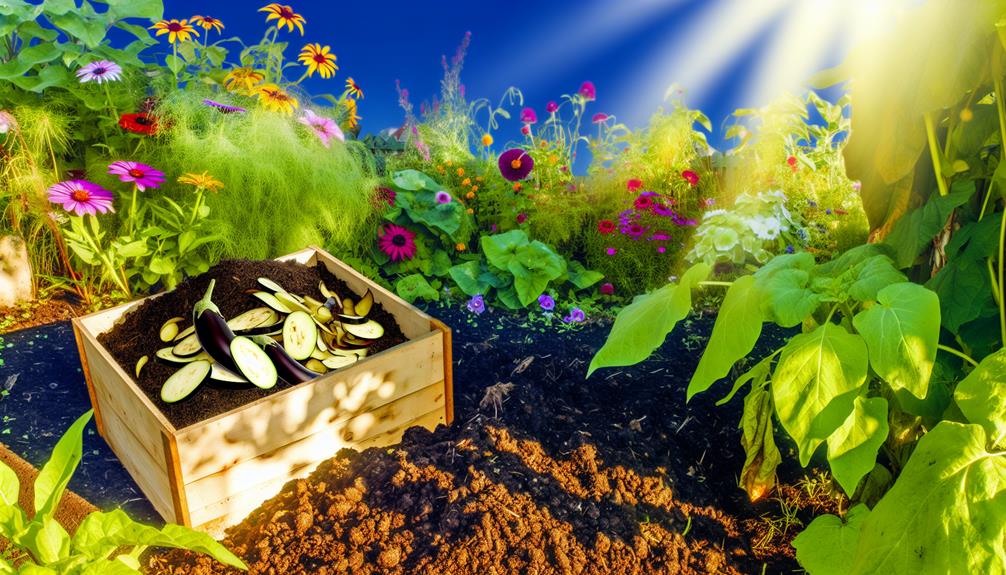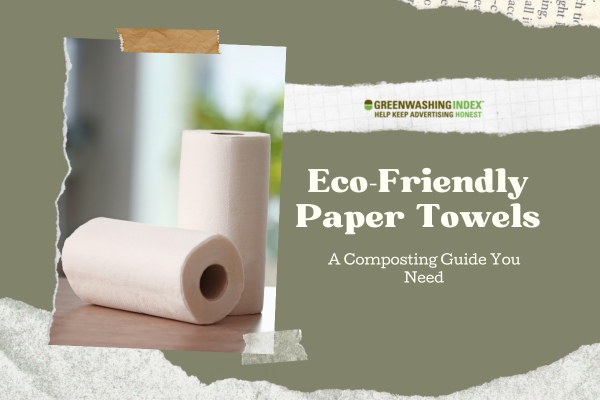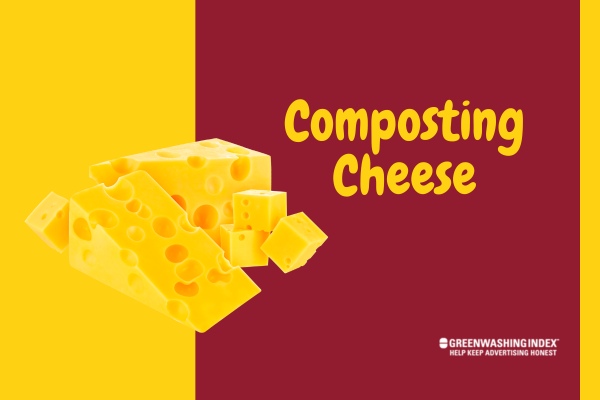Yes, you can compost aubergines. Begin by chopping them into smaller pieces to accelerate decomposition. Aubergines are a green material, rich in nitrogen, so balance them with brown materials like dry leaves or cardboard. Their peels are also compostable and break down quickly. Make sure your compost pile is moist but not waterlogged to avoid rot and odors.
To deter pests, bury aubergine scraps under other compost layers. Mixing aubergine compost ensures it aerates properly, fostering beneficial microbes. Proper composting of aubergines will lead to nutrient-rich compost for your garden, and you’ll learn more about optimizing your compost pile.
Benefits of Composting Aubergine
Composting aubergine enriches your soil with essential nutrients, promoting healthier plant growth. When you add aubergine to your compost pile, it breaks down into a rich, organic matter that boosts the soil’s fertility.
This organic matter improves soil structure, increases water retention, and enhances aeration, making it easier for plant roots to access the nutrients they need. Additionally, composting aubergine helps reduce waste, keeping it out of landfills and contributing to a more sustainable gardening practice.
The decomposed aubergine also introduces beneficial microorganisms into the soil, aiding in the breakdown of other organic materials. By composting aubergine, you not only improve your garden’s productivity but also contribute to a healthier ecosystem.
Preparing Aubergine for Compost
To prepare aubergine for compost, start by cutting it into smaller pieces to speed up the decomposition process.
Here’s a simple guide to get you started:
- Clean the aubergine: Make sure it’s free from any pesticides or chemicals that could harm your compost.
- Remove any stickers or labels: These materials aren’t compostable and should be discarded separately.
- Chop into smaller pieces: Aim for 1-2 inch chunks to increase the surface area for microbes.
- Mix with other compost materials: Combine with greens (like kitchen scraps) and browns (like dry leaves) for a balanced compost.
Also Read: Can You Compost Acorns?
Whole Vs. Chopped Aubergine
Chopping aubergine into smaller pieces can greatly accelerate the composting process compared to composting it whole. When you chop the aubergine, you increase its surface area, allowing microbes to break it down more efficiently.
Whole aubergines take longer to decompose because their thick skin and dense flesh act as barriers for microbial activity.
To chop the aubergine, use a sharp knife and cut it into small chunks or slices. Smaller pieces will mix better with other compost materials and maintain a balanced moisture level.
Balancing Green and Brown Materials
To compost aubergine effectively, you’ll need to balance green materials like kitchen scraps with brown materials such as dried leaves. These components work together to create a healthy compost pile.
Aim for a ratio of about two-thirds brown to one-third green to maintain the right conditions for decomposition.
Green Material Examples
Balancing green materials like aubergine peels with brown materials is crucial in composting. Green materials, rich in nitrogen, encompass kitchen scraps and garden waste. Examples of common green materials include fruit and vegetable scraps, coffee grounds, grass clippings, and plant trimmings.
- Fruit and vegetable scraps: This category comprises peels, cores, and leftover pieces, making aubergine peels a suitable addition.
- Coffee grounds: With their high nitrogen content, coffee grounds contribute effectively to your compost pile.
- Grass clippings: Freshly cut grass serves as another excellent source of green material for composting.
- Plant trimmings: Non-woody plant parts offer a valuable contribution to balancing your compost pile.
Brown Material Sources
When composting, it’s important to include brown materials like dried leaves and cardboard to balance the nitrogen-rich green materials. Brown materials provide the necessary carbon that helps microorganisms break down the compost efficiently.
You can use sources such as shredded newspaper, straw, and wood chips. Even small twigs and sawdust can be valuable additions. Make sure these materials are dry, as moisture can slow down the composting process.
Additionally, avoid glossy paper or treated wood since they can contain harmful chemicals. By diversifying your brown materials, you guarantee a well-aerated and healthy compost pile. Remember, balancing green and brown materials is vital for creating nutrient-rich compost for your garden.
Ideal Ratios Explained
Achieving the ideal ratio of green to brown materials in your compost pile is crucial for the best decomposition. Green materials, like aubergine scraps, are rich in nitrogen, while brown materials, such as dried leaves, provide carbon.
An effective compost pile should have a balance of these elements. Aim for a ratio of about 2:1, browns to greens, to maintain proper aeration and moisture levels.
Here’s a quick guide to help you balance your compost:
- Add two parts brown materials (e.g., straw, cardboard).
- Add one part green materials (e.g., vegetable scraps, coffee grounds).
- Mix thoroughly to ensure even decomposition.
- Monitor and adjust the moisture and aeration regularly.
This balance speeds up composting and reduces odors.
Also Read: Can You Compost Balloon?
Avoiding Pests in Compost
To keep pests out of your compost, make sure you cover food scraps with a layer of yard waste. This simple step helps mask food odors that attract pests like rodents and flies. Shredded leaves, grass clippings, or straw work well. Avoid adding meat, dairy, or oily foods, as they can attract unwanted visitors.
Here’s a quick guide:
| Tip | Description |
|---|---|
| Cover Food Scraps | Use yard waste to conceal food smells. |
| Avoid Meat and Dairy | These items attract pests. |
| Turn Compost Regularly | Aeration helps speed decomposition and deter pests. |
| Use a Bin or Tumbler | Enclosed systems are harder for pests to access. |
Moisture Levels in Compost
Maintaining the right moisture levels in your compost is crucial for efficient decomposition and preventing unpleasant odors. Aim for a consistency similar to a wrung-out sponge.
Here’s how to manage it:
- Check Regularly: Squeeze a handful of compost. It should feel damp but not drip water.
- Adjust Moisture: If it’s too dry, add water or moist materials like fruit scraps. If too wet, mix in dry items like shredded newspaper.
- Turn the Pile: Aerate by turning the pile weekly to distribute moisture evenly.
- Cover Properly: Use a tarp or lid to protect from excessive rain or drying out.
Maintaining these moisture levels ensures your compost remains healthy and effective.
Composting Aubergine Peels
When composting aubergine peels, you’re adding a nutrient-rich component to your compost bin. These peels break down relatively quickly, contributing valuable organic matter and nutrients.

Just make sure to cut them into smaller pieces to speed up the decomposition process.
Nutrient-Rich Compost Addition
Adding aubergine peels to your compost pile can greatly enhance its nutrient content. These peels are rich in essential nutrients like potassium, nitrogen, and phosphorus, which are crucial for healthy plant growth.
To make sure you’re getting the most out of your aubergine peels, follow these steps:
- Chop the peels – Smaller pieces decompose faster, speeding up the composting process.
- Mix with other materials – Combine peels with greens and browns for balanced compost.
- Maintain moisture – Keep your compost pile damp but not waterlogged.
- Turn the pile – Regularly aerate to promote even decomposition.
Decomposition Time Factors
The time it takes for aubergine peels to decompose in your compost pile depends on factors like temperature, moisture, and the balance of materials. If your compost pile is warm and moist, it speeds up the decomposition process. Aim for a temperature between 130-160°F.
Make sure your pile is neither too wet nor too dry; it should feel like a damp sponge. Balance green materials, like aubergine peels, with brown materials, such as leaves or straw, for best decomposition.
Chop the peels into smaller pieces to increase their surface area, which accelerates breakdown. Regularly turning your compost pile also helps by improving aeration.
Following these tips, you can expect aubergine peels to decompose within a few months.
Troubleshooting Common Issues
Despite your best efforts, you might encounter a few common issues when composting aubergine. Here’s how to troubleshoot:
- Rotting Odor: If your compost smells bad, it’s likely too wet. Add dry, carbon-rich materials like leaves or newspaper to balance it out.
- Slow Decomposition: Aubergine might take longer to break down. Chop it into smaller pieces before adding it to your pile.
- Pests: Insects or rodents can become a problem. Cover food scraps with a thick layer of leaves or grass clippings to deter them.
- Mold: White mold is usually harmless, but if it’s excessive, turn the pile to improve aeration and mix in more brown materials.
Also Read: Can You Compost Azuki Beans?
Using Aubergine Compost in Garden
You can enrich your garden soil by incorporating well-composted aubergine, enhancing plant growth and health. Begin by ensuring the compost is fully decomposed; it should be dark, crumbly, and odor-free.

To use it, spread a 2-3 inch layer of aubergine compost over your garden beds and gently mix it into the top few inches of soil. This improves soil structure, boosts nutrient content, and promotes beneficial microbial activity.
For potted plants, mix the compost with regular potting soil at a ratio of 1:3. Be mindful not to overuse the compost, as excessive quantities can lead to nutrient imbalances. Consistently monitor your plants’ health and adjust compost application as needed.
Your garden will thrive with this nutrient-rich addition.
Conclusion
To summarize, composting aubergine is straightforward when you follow a few key steps. Chop the aubergine for faster decomposition, balance green and brown materials, and maintain proper moisture levels to avoid pests. Aubergine peels are also compostable and add valuable nutrients.
By troubleshooting common issues, you can create rich compost for your garden. Implement these tips, and you’ll effectively turn your aubergine scraps into beneficial compost.



